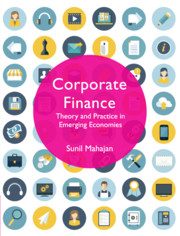Book contents
- Frontmatter
- Contents
- List of Figures
- List of Tables
- List of Corporate Snippets
- List of Abbreviations
- Preface
- Acknowledgements
- 1 Corporate Finance: A Conceptual Introduction
- 2 Financial Markets
- 3 The Time Value of Money
- 4 Capital Budgeting
- 5 Risk and Return
- 6 Valuation
- 7 Capital Structure and Financing
- 8 Dividend Payout: Policy and Practices
- 9 Leverage
- 10 Financial Derivatives
- 11 International Finance
- 12 Working Capital
- 13 Ratio Analysis
- Appendix
- Bibliography
- Index
1 - Corporate Finance: A Conceptual Introduction
Published online by Cambridge University Press: 30 April 2020
- Frontmatter
- Contents
- List of Figures
- List of Tables
- List of Corporate Snippets
- List of Abbreviations
- Preface
- Acknowledgements
- 1 Corporate Finance: A Conceptual Introduction
- 2 Financial Markets
- 3 The Time Value of Money
- 4 Capital Budgeting
- 5 Risk and Return
- 6 Valuation
- 7 Capital Structure and Financing
- 8 Dividend Payout: Policy and Practices
- 9 Leverage
- 10 Financial Derivatives
- 11 International Finance
- 12 Working Capital
- 13 Ratio Analysis
- Appendix
- Bibliography
- Index
Summary
Our goal is to make finance the servant, not the master, of the real economy.
—Alistair DarlingTata Motors Limited (TML) has a capacity to produce 790,000 cars annually. Based on the projected growth of the economy, it must estimate the future demand and decide whether to add another half a million to its capacity. The additional half million vehicles will require substantial investment. If the economy grows at the rate projected by the company's corporate planning department, the investment will prove extremely lucrative. On the other hand, if the growth slackens and other factors do not turn out to be favourable, it can spell doom for the company.
A decision to go ahead with the project would necessitate arrangement of funds for investment. The funds may be raised through either equity or debt. The debt can be short term, to be rolled over on maturity, or for a longer duration. Alternatively, the company can mobilize funds through instruments that are a combination of both debt and equity, as it had done in 1991 by issuing partially convertible bonds. The company can either directly approach a financial institution or it can undertake a public issue whereby it invites the public at large to participate in the financing. There are numerous options available and a choice must be made regarding the best possible combination with which the project can be financed.
An appropriate dividend policy is critical to the company's future success. Shareholder earnings comprise dividends as well as capital gains. Shareholders keenly look forward to receiving dividends from the company. At the same time, the distribution of dividend reduces the cash flows available with the company for investment, besides its implications for capital structure and valuation. A long-term policy must be established that balances the desire of the shareholders to receive dividends on the one hand and the cash flow requirements of the company on the other.
Credit to dealers constitutes a significant proportion of the working capital. Should TML insist on payment on delivery from the dealers, or let them pay only after a vehicle has been sold to the eventual customer? What should be the inventory of vehicles to be stocked with the dealers and in TML's own factory, in addition to the inventory of components it must maintain?
- Type
- Chapter
- Information
- Corporate FinanceTheory and Practice in Emerging Economies, pp. 1 - 21Publisher: Cambridge University PressPrint publication year: 2020

